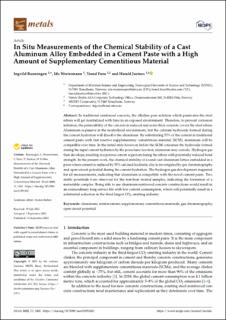| dc.contributor.author | Runningen, Ingvild | |
| dc.contributor.author | Westermann, Ida | |
| dc.contributor.author | Furu, Trond | |
| dc.contributor.author | Justnes, Harald | |
| dc.date.accessioned | 2021-09-15T08:03:40Z | |
| dc.date.available | 2021-09-15T08:03:40Z | |
| dc.date.created | 2021-09-13T08:52:37Z | |
| dc.date.issued | 2021 | |
| dc.identifier.citation | Metals. 2021, 11 (9), . | en_US |
| dc.identifier.issn | 2075-4701 | |
| dc.identifier.uri | https://hdl.handle.net/11250/2777321 | |
| dc.description.abstract | In traditional reinforced concrete, the alkaline pore solution which passivates the steel rebars will get neutralized with time in an exposed environment. Therefore, to prevent corrosion initiation, the permeability of the concrete is reduced and extra-thick concrete covers the steel rebars. Aluminum is passive in the neutralized environment, but the calcium hydroxide formed during the cement hydration will dissolve the aluminum. By substituting 55% of the cement in traditional cement paste with fast reactive supplementary cementitious material (SCM), aluminum will be compatible over time. In the initial state however, before the SCM consumes the hydroxide formed during the rapid cement hydration by the pozzolanic reaction, aluminum may corrode. Hydrogen gas then develops, resulting in a porous cement region enclosing the rebars with potentially reduced bond strength. In the present work, the chemical stability of a sand-cast aluminum lattice embedded in a paste where cement is replaced by 55% calcined kaolinitic clay is investigated by gas chromatography and open-circuit potential during the cement hydration. The hydrogen gas development stagnated for all measurements, indicating that aluminum is compatible with the novel cement paste. Two stable potentials were observed for the non-heat treated samples, indicating the formation of a metastable complex. Being able to use aluminum-reinforced concrete constructions would result in an extraordinary long service life with low cement consumption, which will potentially result in a substantial reduction in the third-largest CO2 emitting industry. | en_US |
| dc.language.iso | eng | en_US |
| dc.publisher | MDPI | en_US |
| dc.rights | Navngivelse 4.0 Internasjonal | * |
| dc.rights.uri | http://creativecommons.org/licenses/by/4.0/deed.no | * |
| dc.title | In Situ Measurements of the Chemical Stability of a Cast Aluminum Alloy Embedded in a Cement Paste with a High Amount of Supplementary Cementitious Material | en_US |
| dc.type | Peer reviewed | en_US |
| dc.type | Journal article | en_US |
| dc.description.version | publishedVersion | en_US |
| dc.source.volume | 11 | en_US |
| dc.source.journal | Metals | en_US |
| dc.source.issue | 9 | en_US |
| dc.identifier.doi | 10.3390/met11091441 | |
| dc.identifier.cristin | 1933569 | |
| dc.relation.project | Norges forskningsråd: 269767 | en_US |
| dc.description.localcode | This is an open access article distributed under the Creative Commons Attribution License which permits unrestricted use, distribution, and reproduction in any medium, provided the original work is properly cited | en_US |
| cristin.ispublished | true | |
| cristin.fulltext | original | |
| cristin.qualitycode | 1 | |

